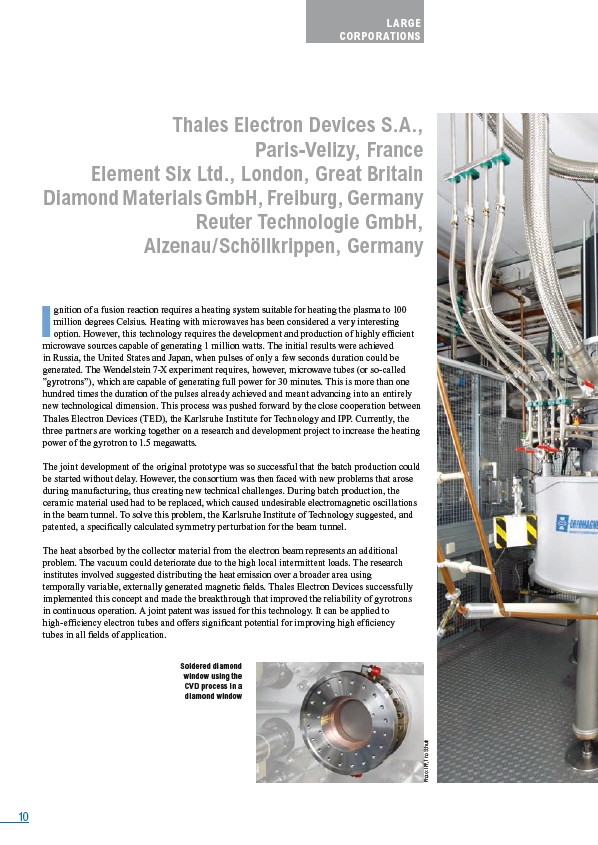
10
LARGE
CORPORATIONS
Thales Electron Devices S.A.,
Paris-Velizy, France
Element Six Ltd., London, Great Britain
Diamond Materials GmbH, Freiburg, Germany
Reuter Technologie GmbH,
Alzenau/Schöllkrippen, Germany
Ignition of a fusion reaction requires a heating system suitable for heating the plasma to 100
million degrees Celsius. Heating with microwaves has been considered a very interesting
option. However, this technology requires the development and production of highly efficient
microwave sources capable of generating 1 million watts. The initial results were achieved
in Russia, the United States and Japan, when pulses of only a few seconds duration could be
generated. The Wendelstein 7-X experiment requires, however, microwave tubes (or so-called
”gyrotrons”), which are capable of generating full power for 30 minutes. This is more than one
hundred times the duration of the pulses already achieved and meant advancing into an entirely
new technological dimension. This process was pushed forward by the close cooperation between
Thales Electron Devices (TED), the Karlsruhe Institute for Technology and IPP. Currently, the
three partners are working together on a research and development project to increase the heating
power of the gyrotron to 1.5 megawatts.
The joint development of the original prototype was so successful that the batch production could
be started without delay. However, the consortium was then faced with new problems that arose
during manufacturing, thus creating new technical challenges. During batch production, the
ceramic material used had to be replaced, which caused undesirable electromagnetic oscillations
in the beam tunnel. To solve this problem, the Karlsruhe Institute of Technology suggested, and
patented, a specifically calculated symmetry perturbation for the beam tunnel.
The heat absorbed by the collector material from the electron beam represents an additional
problem. The vacuum could deteriorate due to the high local intermittent loads. The research
institutes involved suggested distributing the heat emission over a broader area using
temporally variable, externally generated magnetic fields. Thales Electron Devices successfully
implemented this concept and made the breakthrough that improved the reliability of gyrotrons
in continuous operation. A joint patent was issued for this technology. It can be applied to
high-efficiency electron tubes and offers significant potential for improving high efficiency
tubes in all fields of application.
Soldered diamond
window using the
CVD process in a
diamond window
Photo: IPP, Tino Schulz